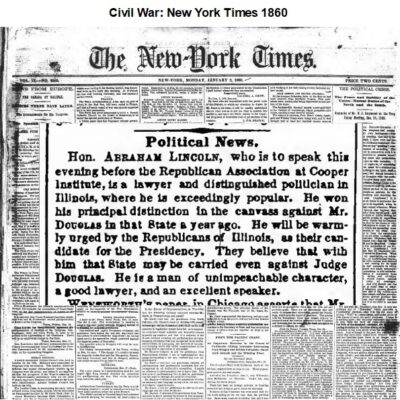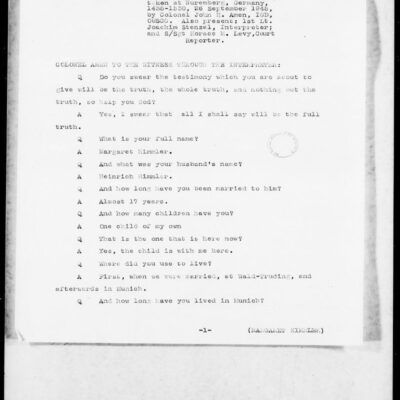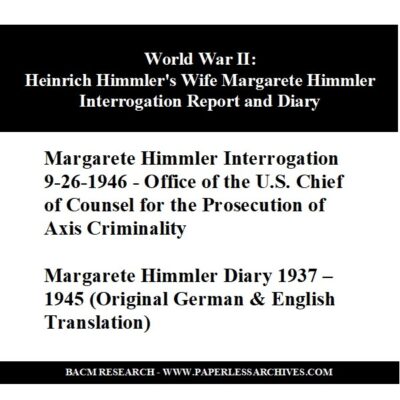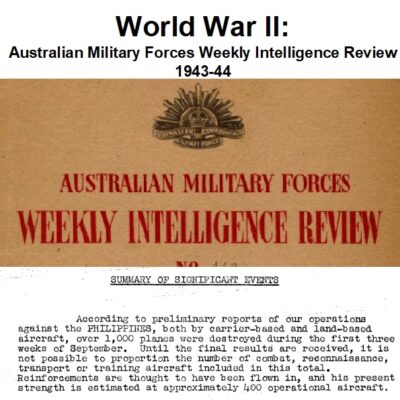
World War II: D-Day President Roosevelt and War Department Planning and Operational Documents
$19.50
Description
D-Day: Genesis of the Second Front
Early War (Unspecified Dates):
- Roosevelt’s “Grand Strategy” Forms: President Roosevelt decides to pursue a “Germany First” strategy, focusing on defeating Nazi Germany as the primary objective. This contrasts with Churchill’s preferred “peripheral strategy.”
- Agreement on a Second Front: Both Roosevelt and Churchill agree that a second front in Europe is necessary to defeat Germany, believing an unconditional surrender is impossible without it.
- Stalin’s Pressure for a Second Front: Soviet leader Joseph Stalin consistently presses for a second front to relieve pressure on the Russian army on the Eastern Front.
1943:
- Spring 1943 – Original D-Day Plan (“Operation Sledgehammer”) Postponed: Initial plans for an invasion of Western Europe (“Operation Sledgehammer”) are set for spring 1943. However, the demands of fighting in two theaters prevent the U.S. from providing necessary resources (ships, landing crafts, troops), leading to its postponement.
- Shift to North Africa (“Operation Torch”): Focus shifts from Western Europe to an invasion of Northwest Africa. This operation is the first major engagement of U.S. troops against the German army and pushes back any Western European invasion.
- February 1943 – Casablanca Conference: Roosevelt and Churchill meet in Casablanca and agree on an invasion of Sicily to begin in July. This aligns with Churchill’s peripheral strategy.
- July 1943 (Onward) – North African and Italian Campaigns: The invasion of Sicily begins, leading to subsequent campaigns in North Africa and Italy. These fights prove “longer and harder” than anticipated, with Allied defeats at Dunkirk, Anzio, and Salerno.
Late 1943 – Early 1944:
- Agreement on Normandy Invasion: General Dwight Eisenhower and British Field Marshal Bernard Montgomery agree that a massive invasion of Normandy is essential.
- Churchill’s Initial Resistance to Normandy: Churchill continues to prefer peripheral attacks over a large, direct assault into Western Europe.
- January 1944 – Churchill Supports “Operation Overlord”: With Stalin also supporting a Normandy invasion, Churchill begins to indicate support for “Operation Overlord.”
June 1944:
- Days Leading Up to D-Day – Planning Changes: Plans for D-Day undergo regular changes due to the pace of American preparations, battlefield fortunes, Stalin’s influence, and weather conditions.
- June 6, 1944 – D-Day (“Operation Overlord”): As dawn breaks, mostly American, British, Canadian, and Free French troops (with participation from Australian, Czech, Polish, Norwegian, and New Zealander troops) land on five beaches along the Normandy coast of France. This marks the largest amphibious military assault in history.
- June 6, 1944 (End of Day) – Roosevelt’s Radio Address: At the end of the first day of Operation Overlord, President Roosevelt addresses the American public by radio, delivering his address in the form of a prayer.
- June 6, 1944 (Onward) – Establishment of the “Second Front”: The success of Operation Overlord leads to the establishment of a “Second Front” in Europe, forcing Hitler to fight the Red Army in the East and expanding Anglo-American-Canadian led forces in the West.
- D-Day Casualties: Allied D-Day casualties are approximately 10,000, with 4,414 confirmed dead. German losses are estimated between 4,000 and 9,000 soldiers.
August 1944:
- August 15, 1944 – “Operation Anvil” (Later “Operation Dragoon”): The landing operation for the Allied invasion of Provence (Southern France) takes place. Originally planned to coincide with Overlord, it was postponed due to resource limitations.
- Late August 1944 – Liberation of Northern France: All of northern France is liberated from German control.
Ten Months After D-Day (April 1945):
- Allied Victory in Europe: Allied forces complete the defeat of Nazi Germany.
Cast of Characters
- President Franklin D. Roosevelt (FDR): The President of the United States during World War II. He advocated for the “Germany First” strategy and was the architect of the “Grand Strategy” for defeating the Axis powers. His administration’s War Department and Joint Chiefs of Staff were heavily involved in planning and executing operations like Overlord and Anvil. He maintained correspondence with Churchill and participated in meetings with Allied leaders.
- Prime Minister Winston Churchill: The Prime Minister of the United Kingdom during World War II. Initially favored a “peripheral strategy” (e.g., North Africa, Italy) over a direct invasion of mainland Europe. He corresponded with Roosevelt and participated in Allied leadership meetings. He eventually supported Operation Overlord in January 1944.
- Marshal Joseph Stalin: The leader of the Soviet Union during World War II. He consistently pressed Roosevelt and Churchill for the opening of a “Second Front” in Western Europe to relieve pressure on the Red Army fighting on the Eastern Front. His influence played a role in the timing and urgency of D-Day plans.
- General Dwight D. Eisenhower: A key American military commander. He agreed with Montgomery that a massive invasion of Normandy was necessary for the defeat of Germany. He would later become the Supreme Allied Commander of the Allied Expeditionary Force, overseeing Operation Overlord.
- Field Marshal Bernard Montgomery: A key British military commander. He agreed with Eisenhower that a massive invasion of Normandy was necessary.
World War II: D-Day President Roosevelt and War Department Planning and Operational Documents
6,143 pages of President Franklin D. Roosevelt, Roosevelt Administration’s War Department and Joint Chiefs of Staff files related to Operation Overlord, the invasion of Northwestern Europe entering through Northern France. The invasion is commonly known today as D-Day. The material also includes information about Operation Anvil. Anvil was the code name for the landing operation of the Allied invasion of Provence (Southern France) on 15 August 1944. The operation was initially planned to be executed in conjunction with Operation Overlord, the Allied landing in Normandy, but the lack of available resources led to a postponement of the second landing.
Materials include: Correspondences between President Roosevelt and Prime Minister Churchill, strategic studies, intelligence reports, outline plans, operational reports, minutes of FDR meetings with the Joint Chiefs of Staff, FDR drafts of speeches with handwritten notations and changes, plans for and minutes of the meetings between President Roosevelt, Marshal Stalin and Prime Minister Churchill.
The D-Day invasion was the carrying out of President Roosevelt’s “Grand Strategy.” FDR wanted to pursue a “Germany First” strategy. This policy was in contrast to British Prime Minister Winston Churchill’s preference for a peripheral strategy.
Early in the war, both President Roosevelt and Prime Minister Churchill believed that a second front needed to be open in Europe to defeat Germany. Both believed that without an invasion deep into mainland Europe, an unconditional surrender of Nazi Germany would not be possible. Soviet leader Joseph Stalin was pressing for the relief a second front would give the Russian army on the east front. As the war was executed, a divergence emerged between the two leaders on the timing and urgency for opening the new front.
The pace of progress of American preparations, vicissitudes of fortune on the battlefield, the influence of Stalin, and in the days leading up to the invasion, weather conditions, caused regular changes in the plans for D-Day.
Originally plans were for an invasion, “Operation Sledgehammer,” to take place in spring of 1943. However, the demands of fighting in two theaters meant that America would not be able to provide the necessary ships, landing crafts and troops by that time. Focus moved from an invasion of Western Europe, to an invasion of Northwest Africa, “Operation Torch.” The operation pushed back any invasion of Western Europe; however, it was the first major operation U.S. troops took against the German army.
When in February 1943 Roosevelt and Churchill met in Casablanca they agreed on an invasion of Sicily beginning in July, an enactment of Churchill’s peripheral strategy. Unfortunately for the Allies, the North African and Italian campaigns were longer and harder fights than anticipated, with defeats at Dunkirk, Anzio, and Salerno.
General Dwight Eisenhower and British Field Marshall Bernard Montgomery agreed that a massive invasion of Normandy was necessary. Churchill preferred to stick with peripheral attacks and avoiding a large direct attack into Western Europe. With Stalin also supporting a Normandy invasion, in January 1944 Churchill began indicating support for “Operation Overlord.”
After years of planning, as dawn broke on June 6, 1944, mostly American, British, Canadian and Free French troops landed on five beaches along the Normandy coast of France. The largest amphibious military assault in history. Also participating were Australian, Czech, Polish, Norwegian, and New Zealander troops.
At the end of the first day of Operation Overlord, Roosevelt addressed the American public by radio. His address took the form of a prayer. The success of Operation Overlord leads to an establishment of a “Second Front” in Europe. Hitler now faced fighting the Red Army in the East and expanding Anglo-American-Canadian lead forces in the West.
Allied D-Day casualties were approximately 10,000, with 4,414 confirmed dead. German losses are estimated to have been between 4,000 and 9,000 soldiers. By late-August 1944, all of northern France was liberated from German control. Ten months later Allied forces completed the defeat of Nazi Germany.
Related products
-


Civil War: New York Times 1860
$9.90 Add to Cart -


Operation POPEYE in the Vietnam War
$5.94 Add to Cart -


World War II: Interrogation Report and Diary of Margarete Himmler, Wife of Heinrich Himmler
$3.94 Add to Cart -


World War II: Australian Military Weekly Intelligence Reports 1943-44
$3.94 Add to Cart